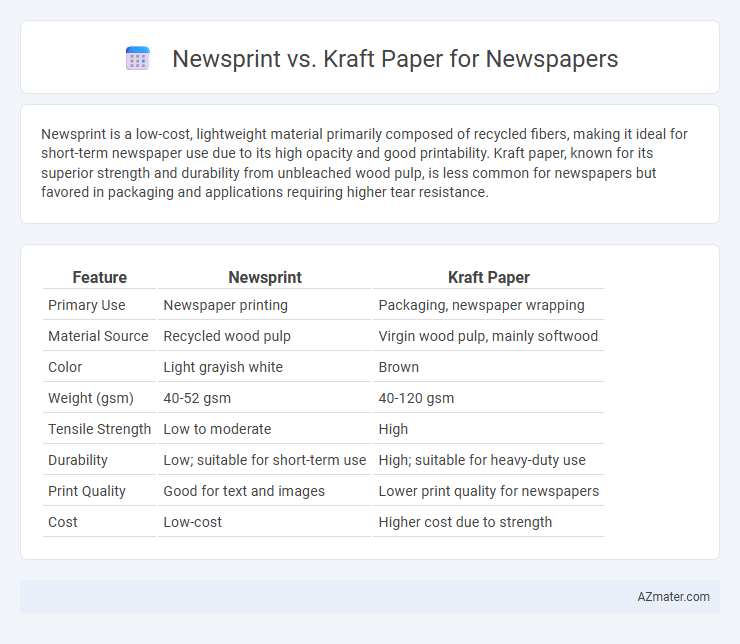Newsprint is a low-cost, lightweight material primarily composed of recycled fibers, making it ideal for short-term newspaper use due to its high opacity and good printability. Kraft paper, known for its superior strength and durability from unbleached wood pulp, is less common for newspapers but favored in packaging and applications requiring higher tear resistance.
Table of Comparison
| Feature | Newsprint | Kraft Paper |
|---|---|---|
| Primary Use | Newspaper printing | Packaging, newspaper wrapping |
| Material Source | Recycled wood pulp | Virgin wood pulp, mainly softwood |
| Color | Light grayish white | Brown |
| Weight (gsm) | 40-52 gsm | 40-120 gsm |
| Tensile Strength | Low to moderate | High |
| Durability | Low; suitable for short-term use | High; suitable for heavy-duty use |
| Print Quality | Good for text and images | Lower print quality for newspapers |
| Cost | Low-cost | Higher cost due to strength |
Overview of Newsprint and Kraft Paper
Newsprint is a low-cost, lightweight paper primarily made from mechanical wood pulp, known for its high opacity and brightness, making it ideal for newspaper printing. Kraft paper, derived from chemical pulp through the kraft process, offers superior strength, durability, and tear resistance, often used for packaging and heavier-duty applications. While newsprint focuses on cost-efficiency and printability for large-scale newspaper distribution, kraft paper emphasizes robustness and longevity.
Key Differences in Material Composition
Newsprint consists primarily of low-cost, mechanically pulped wood fibers with high lignin content, resulting in a lightweight and inexpensive paper ideal for mass newspaper printing. Kraft paper, derived from chemically processed wood pulp using the kraft process, offers stronger fibers and higher durability due to the removal of lignin and impurities. The difference in material composition directly affects print quality, strength, and longevity, with newsprint favoring cost and recyclability, while kraft paper emphasizes toughness and resistance to tearing.
Print Quality and Readability Comparison
Newsprint offers balanced print quality with moderate brightness and opacity, enabling clear text reproduction and effective ink absorption, making it ideal for mass-circulation newspapers. Kraft paper, while stronger and more durable due to its high lignin content, typically has lower whiteness and higher opacity, which can lead to reduced print sharpness and less contrast in printed text. For optimal readability and sharp image clarity in newspaper printing, newsprint remains the preferred choice due to its engineered surface characteristics tailored for high-speed rotary presses.
Environmental Impact and Sustainability
Newsprint, primarily made from recycled fibers, offers lower energy consumption and reduced carbon emissions compared to Kraft paper, which relies heavily on virgin wood pulp. Kraft paper production involves more intensive chemical processing and higher water usage, contributing to greater environmental degradation. Opting for newsprint supports circular economy initiatives by promoting recycling and minimizing deforestation, enhancing overall sustainability in newspaper manufacturing.
Cost and Economic Considerations
Newsprint offers a lower-cost option for newspaper production due to its lightweight composition and high-speed manufacturing process, making it economically favorable for large print runs. Kraft paper, while more durable and resistant to tearing, involves higher raw material and processing costs that can significantly increase overall production expenses. Choosing newsprint optimizes budget efficiency without sacrificing print quality in standard newspaper applications, whereas kraft paper suits niche markets demanding enhanced strength despite higher costs.
Durability and Lifespan of Each Paper
Newsprint, commonly used for newspapers, offers low durability and a short lifespan due to its high wood pulp content and minimal processing, causing it to yellow and become brittle quickly. Kraft paper, made from stronger, chemically processed wood fibers, provides superior durability and a longer lifespan, making it more resistant to tearing and moisture for archival-quality applications. For newspapers requiring extended readability and preservation, kraft paper is a more durable choice compared to traditional newsprint.
Ink Absorption and Image Reproduction
Newsprint offers superior ink absorption, ensuring sharper image reproduction and more vibrant colors essential for newspaper clarity. Kraft paper, while stronger and more durable, has a coarser texture that results in less precise ink absorption, leading to muted images and reduced print detail. Choosing newsprint optimizes print quality for detailed photographs and crisp text, whereas kraft paper prioritizes durability over visual finesse.
Sourcing and Availability Factors
Newsprint is primarily sourced from recycled fibers and softwood pulp, making it more sustainable but reliant on consistent supply chains of recovered paper. Kraft paper, produced from virgin wood fibers through the kraft process, offers greater strength but depends heavily on forestry resources and sustainable logging practices. Availability of newsprint tends to fluctuate with recycling rates and market demand, while kraft paper availability is influenced by forestry regulations and raw material costs.
Industry Trends and Market Preferences
Newsprint remains the dominant choice in the newspaper industry due to its cost-effectiveness and excellent print quality, supporting high-volume production demands. Kraft paper, favored for its durability and eco-friendly attributes, is gaining traction in niche markets emphasizing sustainability and recyclable packaging. Current market trends indicate a gradual shift towards recycled and sustainable fibers in newsprint production, driven by environmental regulations and consumer preferences.
Choosing the Best Paper for Newspapers
Newsprint offers cost-effective, lightweight qualities ideal for high-volume newspaper production, providing good print clarity for text and images. Kraft paper delivers superior durability and tear resistance, making it suitable for newspapers requiring enhanced strength and longevity. Selecting the best paper depends on balancing budget constraints, print quality needs, and the intended lifespan of the newspaper.

Infographic: Newsprint vs Kraft paper for Newspaper
 azmater.com
azmater.com